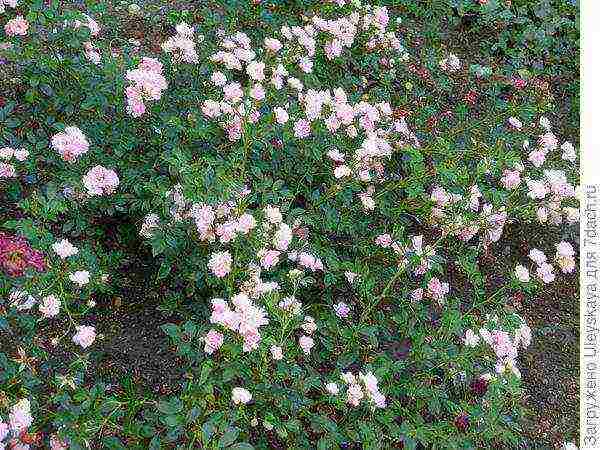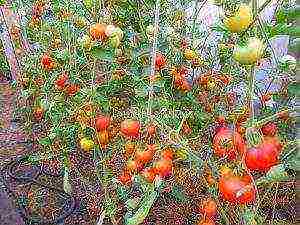Content
- 1 The history of the appearance of miniature roses
- 2 Advantages of miniature roses
- 3 The success of growing miniature roses
- 4 Application in the country
- 5 The best varieties of miniature roses
- 5.1 Miniature rose 'Baby Bunting' variety
- 5.2 Miniature rose cultivar 'Bigoudi'
- 5.3 Miniature rose cultivar 'Cinderella'
- 5.4 Miniature rose cultivar 'Colibri'
- 5.5 Miniature rose ‘Green Ice’
- 5.6 Miniature rose cultivar ‘Daniela’
- 5.7 Miniature rose ‘Fresh Pink’
- 5.8 Miniature rose ‘Gold Symphonie’
- 5.9 Miniature rose cultivar 'Lavender Meillandina'
- 5.10 Miniature rose cultivar 'Maidy'
- 5.11 Miniature rose cultivar 'Mandarine Symphonie'
- 5.12 Miniature rose cultivar ‘Mr. Bluebird '
- 5.13 Miniature rose cultivar 'Rouletii'
- 5.14 Miniature rose cultivar 'Stars'n Stripes'
- 5.15 Miniature rose cultivar 'Sunmaid'
- 5.16 Miniature rose variety 'Pomegranate Bracelet'
- 5.17 Miniature rose variety 'Boy-with-Finger'
- 5.18 Miniature rose cultivar 'Zwergkonigin'
- 6 Miniature roses in landscape design (with photo)
- 7 Growing miniature roses: care and pruning
- 8 The best varieties of miniature roses: photo and description
- 9 Classification of varieties of roses. What types are there and how to distinguish between them?
- 10 Floribunda roses. Varieties, photos, description
- 11 The best types of climbing roses, names and descriptions
- 12 Varieties of hybrid tea roses
- 13 Roses with the largest flowers
- 14 The most beautiful varieties of miniature and dwarf roses
- 15 Long-stemmed yellow, orange and red rose varieties
Today, more and more often in the most ceremonial places of summer cottages, you can find miniature roses in containers, pots. They were successfully bred in indoor conditions, where they bloom tirelessly throughout the year.

The history of the appearance of miniature roses
The history of their origin goes back to the 19th century, when dwarf tea roses were brought from China to Europe in 1810. The first official information about them as a dwarf ever-flowering rose (Rosa semperflorens minima) appeared in print in 1815. Then the Laurenz rose (Rosa Lawrenceana), the Indian rose (Rosa indica) appeared in Switzerland, and the famous variety was created on their basis 'Rouletii' - the founder of the first modern varieties of miniature roses.
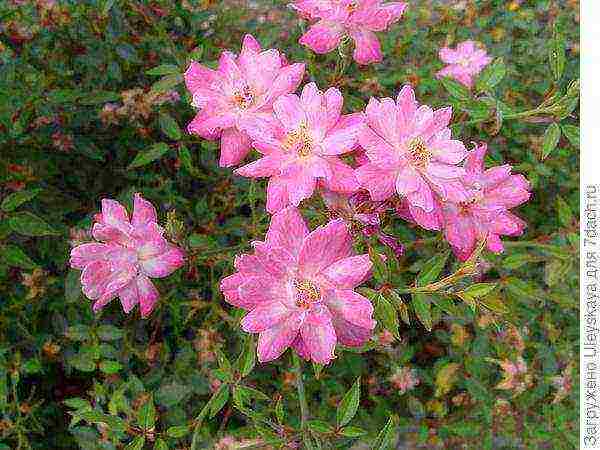
Naturally, European breeders have never seen anything like this before. Crossing the first varieties with low polyanthus and other roses, they got smaller copies of garden roses, which they combined into a separate group of miniature roses.
Advantages of miniature roses
- in dwarfs from 5 to 30 (45) cm in height, unlike ground cover roses at the same height, the shoots do not fall down in an arc and do not spread over the ground for several meters;
- they are densely leafy, their crowns consist of small, often shiny leaves;
- often abundantly decorated with small fragrant flowers of a wide variety of colors: red, orange, yellow, pink, white, two-color, green, lilac;
- there are varieties in which the color changes as the flower ages from lemon yellow to cherry red;
- most often 3-15 flowers are collected in compact inflorescences;
- there are terry varieties;
- their flowering lasts from May until frost, and has 3 waves: spring, summer and autumn.
The success of growing miniature roses
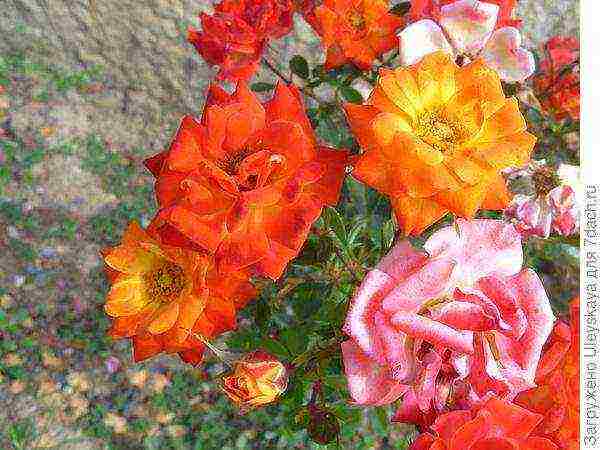
- they are easily propagated by cuttings;
- in central Russia, they winter easily covered with spruce branches and covered with snow;
- if the shoots freeze over in severe snowless winters, then they are removed during spring pruning and this does not affect the abundance of flowering next year;
- in the southern zone of horticulture, as a rule, miniature roses winter covered with snow;
- they are resistant to pests and fungal diseases.
Application in the country
Miniature roses are good in borders, flower beds, rockeries, when decorating balconies, in containers, and in pot culture. They are used for grafting on boles, in a cut for boutonnieres.
The best varieties of miniature roses
Today miniature roses are a self-sufficient garden group of 5,000 varieties. Let's get acquainted with the best of them that can now be seen in Crimea.
Miniature rose 'Baby Bunting' variety

An old variety, created in the Netherlands in 1953. The bush is not compact, up to 35 cm high. Flowers up to 4.5 cm in diameter, carmine-red with a pink center, semi-double, slightly aromatic; bloom from May to autumn. Medium-strong resistance to fungal diseases.
Application A good variety for curbs, ridges, container culture. Will be beautiful in the foreground of mixborders.
Miniature rose cultivar 'Bigoudi'

The ‘Bigoudi’ variety was created by the French company Meilland in 2001. The bushes are up to 45 cm high. The leaves are green, shiny. The flowers are small, up to 5 cm in diameter, red with yellow strokes, double, slightly fragrant, collected in inflorescences. Blooming remontant (repeated), prolonged (long-lasting), begins in June.
Application A variety for an amateur, since some growers do not like such variegation of petals at all. But it will be clearly loved by children who will appreciate both its small size and cheerful coloring. Suitable for groups, curbs, boles and potting. The variety is quite frost-resistant in the southern zone of horticulture, but is weak against fungal diseases: it is strongly affected by black spot, moderately resistant to powdery mildew.
Miniature rose cultivar 'Cinderella'
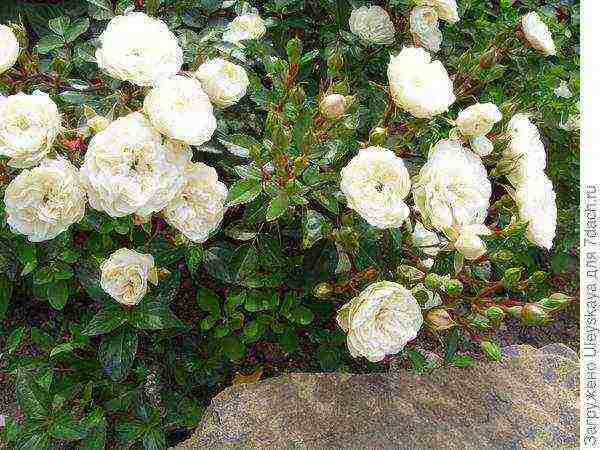
An old variety. Bushes up to 30-40 cm high and 20 cm wide, compact, shoots without thorns. Flowers up to 3 cm in diameter, white, often turning pink when cold, with a spicy aroma; in inflorescences 5-20 flowers. Abundant and long flowering from early summer. Moderately resistant to powdery mildew and not resistant to black spot.
Application Good in rockeries, borders, containers. The absence of thorns makes this variety suitable for use in the children's area of the summer cottage.
Miniature rose cultivar 'Colibri'
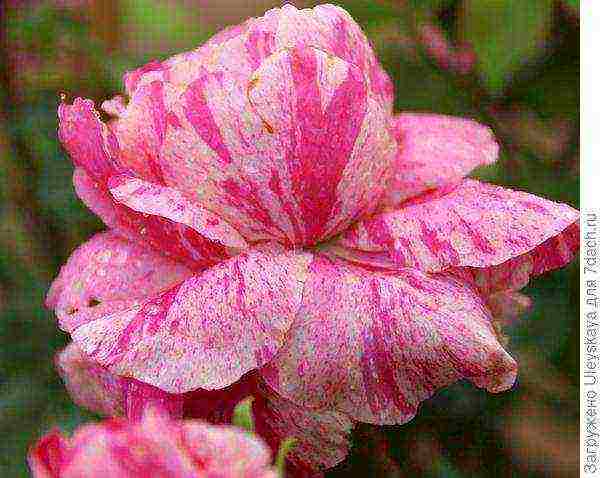
Such varieties are said to be historical. The ‘Colibri’ variety was created by the French firm Meilland in 1958. 20 years later the breeders of the same firm improved it, and the rare apricot-orange color of the rose petals became even more intense. Bushes up to 25 cm high, compact. The leaves are dark green, leathery, shiny. The flowers are cup-shaped, 3-4 cm in diameter, orange, double, very fragrant; collected in inflorescences of 3-5 pieces; bloom from early summer to autumn. In the southern zone of horticulture, covered with snow, the variety is frost-hardy; in central Russia needs more serious warming with spruce branches. Resistant to fungal diseases.
Application A very bright, elegant mini-variety, from which you can arrange borders, ridges; it is grafted onto low stems. It is effective in containers on balconies and pots in indoor culture. Beautiful cut in mini-bouquets for babies.
Miniature rose ‘Green Ice’
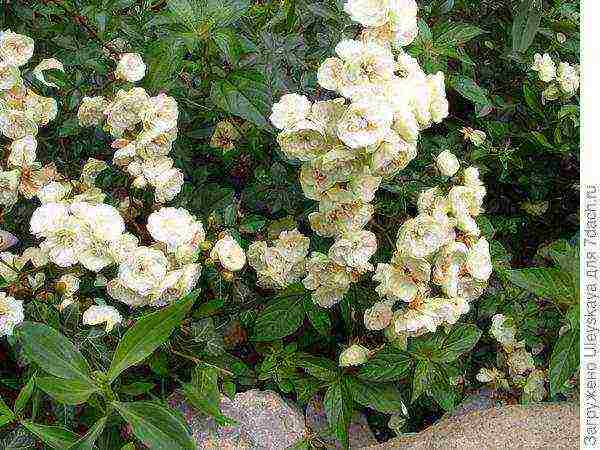
An unusually interesting green miniature rose, created in America in 1971 (originator Ralph Moore). Sprawling bush, 30-45 cm high. Leaves are dark green, shiny. Flowers up to 3 cm in diameter, double, white with a green tint, with a delicate aroma, collected in 3-7 pieces. Blossom in early summer and until autumn the flowering is repeated (remontant). Resistant to fungal diseases, but rains "spoil" it.
Application The variety can be used in flower gardens and rockeries; it perfectly retains its decorative qualities both in the light and in partial shade. Used when growing in a room.
Miniature rose cultivar ‘Daniela’

A very gentle variety, bred by the German company Kordes' Söhne in 1987. The bushes are low, 15-30 cm high, compact. Leaves are green, matte. Double flowers with a diameter of 3 cm, with a subtle delicate aroma, collected in inflorescences up to 20 buds.The petals are pointed, of an unusual star-tiled shape, pink (fade in the sun). They bloom profusely and for a very long time. Winter hardy in the South Horticultural Zone, where it is sheltered anyway. Only on the Black Sea coast of the Krasnodar Territory and the southern coast of Crimea does it need shelter for the winter. Medium resistant to fungal diseases.
Application A successful mini-variety that has found its place in borders, rockeries; it is used in room culture, grafted on low boles. The flowers are suitable for boutonnieres.
Miniature rose ‘Fresh Pink’
A very beautiful, already historical variety, created by R.S. Moore in 1964 Bushes 30-35 cm high, loose. The leaves are dark green, shiny, leathery. Flowers 3-4 cm in diameter, cupped, light pink, collected in inflorescences of 3-12 pieces; bloom from May to autumn. The first wave of flowering is especially abundant. It is frost-hardy in the southern horticulture zone. Resistant to fungal diseases.
Application An excellent delicate variety for borders, ridges, mixborders, as well as for container and pot culture.
Miniature rose ‘Gold Symphonie’
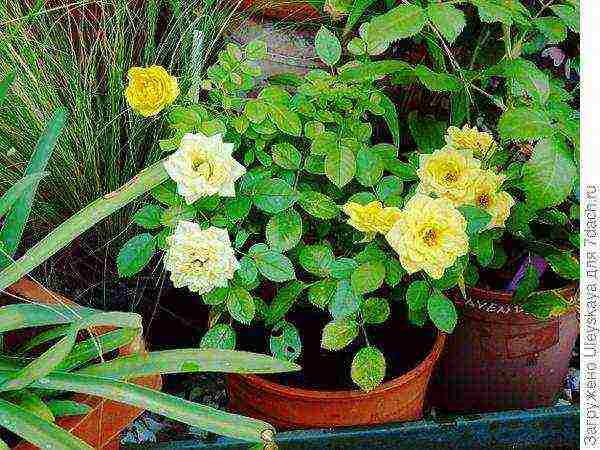
The variety was created by the French company Meilland in 2001. Bushes up to 40 cm high, compact. Leaves are green, leathery. The flowers are large for miniature roses (up to 6 cm in diameter), golden yellow, double. They bloom from the first ten days of May and bloom profusely and for a long time until autumn.
Application This luxurious "golden" miniature variety will look great in borders, it will not get lost on the ridges, in mixborders. In pots and container culture, he will be unmatched!
Miniature rose cultivar 'Lavender Meillandina'
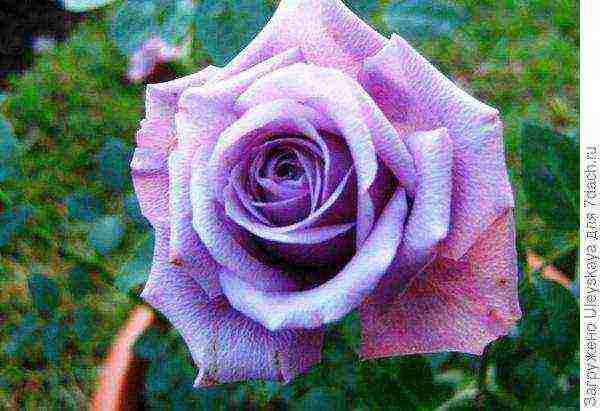
An unusually beautiful variety created by Meiyan in 1999; may be found on sale under the name 'Lavender Sunblaze'. The bush is 40-50 cm high and up to 40 cm wide, densely leafy, almost without thorns. Leaves are dense, leathery. Flowers with a diameter of 4-6 cm, lilac-purple, densely double, slightly fragrant; single or 2-5 in inflorescences. Blooms throughout the summer. In the southern zone of horticulture, the variety is frost-hardy, in central Russia it needs to be covered with spruce branches and snow. Resistant to fungal diseases, but vulnerable to rain.
Application The variety deserves the attention of lovers of lavender color, this color of flowers looks advantageous with various bells against a background of silvery leaves. It can be used in the design of a children's area. Good in mini flower beds, container and pot culture.
Miniature rose cultivar 'Maidy'
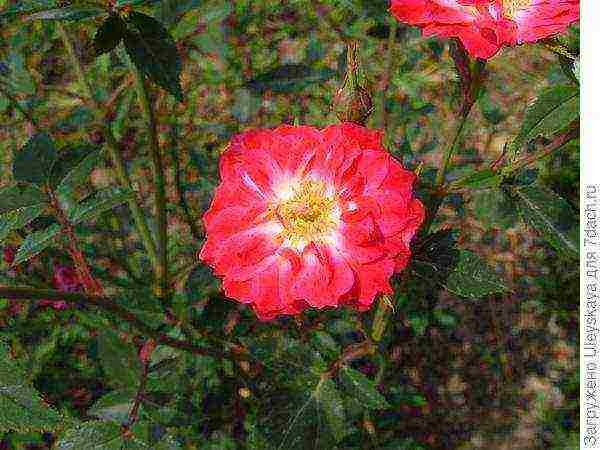
A very interesting bright variety, created by the German company Kordes in 1984. The bush is up to 35 cm high, dense, compact. The leaves are dark green, leathery, shiny. Terry flowers are large, up to 5 cm in diameter, slightly fragrant. The color of pointed petals, neatly folded in the form of a tile, is two-colored: in the center they are white, to the edge they are dark red. Blossom profusely throughout the season. In the southern zone of horticulture it is frost-resistant, in the middle lane we cover it with spruce branches and snow. Medium resistant to powdery mildew, vulnerable to black spot.
Application A fabulous variety for growing in pots, containers, but it fully "reveals" itself in the open field - in solitary (single) or group plantings, on low boles. Doesn't need any addition.
Miniature rose cultivar 'Mandarine Symphonie'
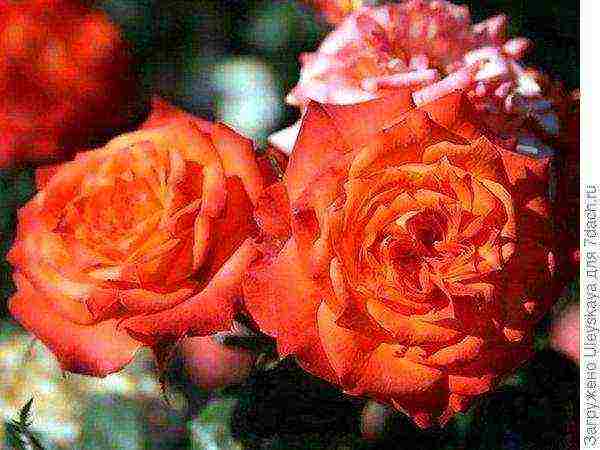
This miniature variety is in tune with music, which, together with flowers, gives joy and good mood. It was created in 2000 by the famous Meilland company, which presented the world with a huge number of beautiful varieties of roses. Bushes are low, compact. The leaves are dark green, small. Terry bright orange (yellow below) flowers of medium size are collected in inflorescences. Bloom for a long time, re-flowering.
Application Effective in groups. You can create bright floral borders from it.
Miniature rose cultivar ‘Mr. Bluebird '
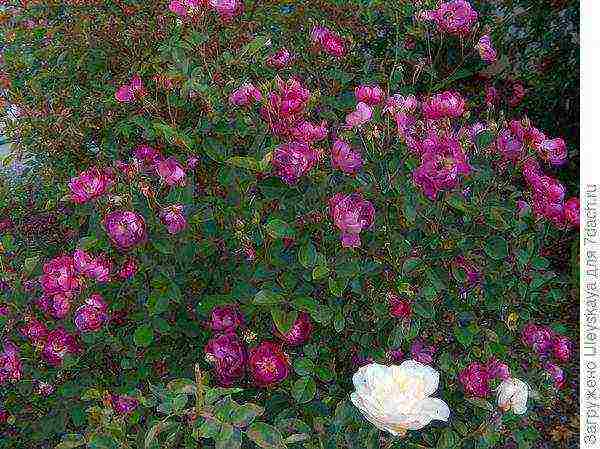
The miniature rose variety under this name is unusual! Like little birds perched on the branches of a bush. The variety was created by the American breeder R. Moore in 1960.Bush up to 50 cm high, flowers 3-4 cm in diameter, mauve with a white eye in the center, semi-double, without aroma, collected in 7-15 inflorescences. Blossom during the summer and into late autumn.
Application Suitable for curbs, rabatok, suitable for indoor cultivation.
Miniature rose cultivar 'Rouletii'
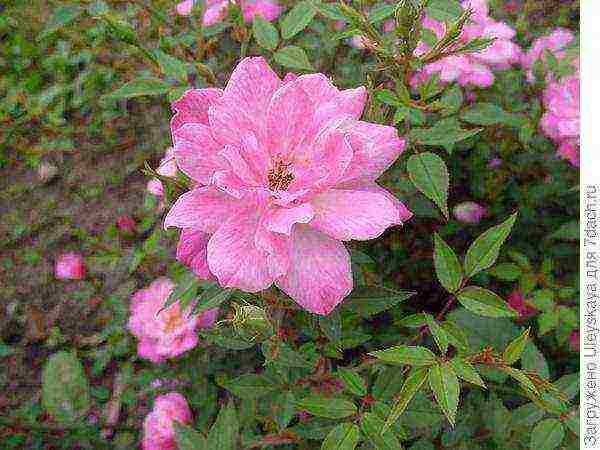
An old variety improved by Roulet in 1920. It can be marketed under other names such as Rosa chinensis var. minima, R. 'Pompon de Paris'. Bushes are erect, 20-40 cm high, 20 cm wide, openwork. The leaves are small, narrow. Semi-double flowers are small, 2-4 cm in diameter, cupped, pinkish-fuchsia (lilac-lavender when flowering), fragrant, collected in inflorescences up to 25 pieces. Blossom abundantly and for a long time (on the southern coast of Crimea - until December). The variety is frost-hardy in the southern zone of horticulture, unpretentious, sometimes affected by powdery mildew.
Application Despite the delicacy, landscape designers love to use this variety in borders, ridges. Some hobbyists plant it on boles, plant it in raised flower beds, and grow it in containers and pots.
Miniature rose cultivar 'Stars'n Stripes'

This charming variety was created by R. Moore in 1975. Unequal bush 30-40 cm high, up to 70 cm wide seems more open than upright, shoots without thorns. The leaves are small, dark green. The flowers are goblet, up to 4.5 cm in diameter, in a red-pink strip, semi-double, fragrant, collected on long refined shoots of 3-5 pieces. Blossom from summer to late autumn. Unpretentious, winter-hardy (in central Russia it requires shelter with spruce branches and snow), resistant to fungal diseases. In cool and humid summers, it is sometimes affected by powdery mildew.
Application The variety is as if created for children who, with all their childlike spontaneity, will certainly appreciate it. Suitable for planting in a small children's corner in the country or in a pot on the terrace. Good in small gardens, suitable for growing on low boles, in a pot culture.
Miniature rose ‘Sunmaid’
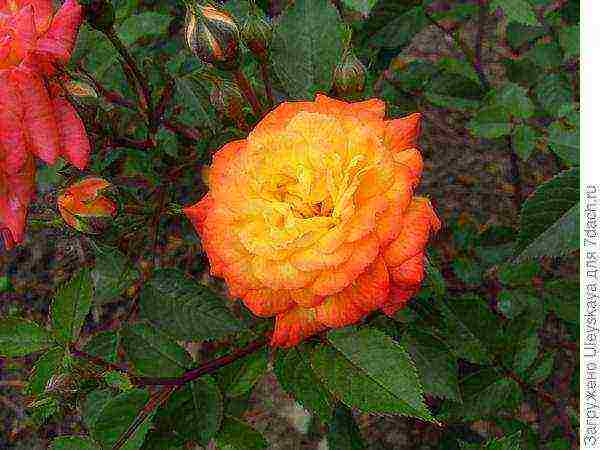
The name of this variety was given by the originator J. Spek in 1972. The bushes are low, 30-40 cm high, compact, densely leafy. The leaves are dark green, leathery, shiny. Double flowers with a diameter of 2.5-4 cm, bright orange (reddening and turning pink as they bloom), with a delicate aroma, collected in inflorescences of 3-10 pieces. Blossom from summer to autumn (several waves of flowering).
Application Good in borders, ridges, used on boles and in container, pot culture.
Miniature rose variety 'Pomegranate Bracelet'
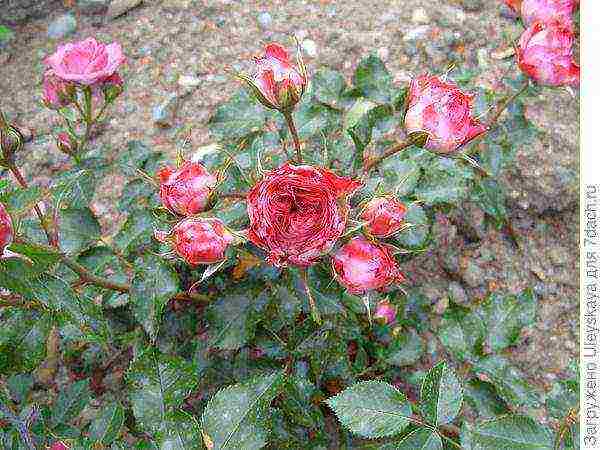
Domestic variety created by Zinaida Konstantinovna Klimenko in Crimea in 2007. Bushes 30-35 cm high, densely leafy. Leaves are dark green, shiny, toothed, wavy. Densely double flowers are large, up to 7 cm in diameter, two-colored, pink-white, the shape is old, the bud remains half-open. They bloom profusely and tirelessly until late autumn. Winter-hardy in the southern gardening zone. Resistant to fungal diseases
Application An unusually beautiful variety that can be used to create borders, ridges; it will not get lost in the mixborders in the foreground; can be grafted onto low stems and grown in containers and pot culture.
Miniature rose variety 'Boy-with-Finger'
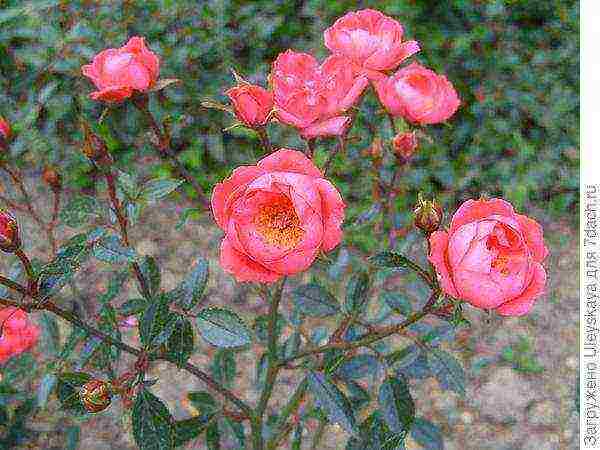
A luxurious domestic variety created by the spouses Konstantin Ivanovich Zykov and Zinaida Konstantinovna Klimenko in 2008. Bushes 30-40 cm high, compact, densely leafy. The leaves are dark green, small, elongated. The flowers are small, up to 4 cm in diameter, red, cupped, semi-double, collected in inflorescences from 3 to 100 pieces, with a delicate aroma. Blossom profusely and for a long time. Winter-hardy in the southern gardening zone.
Application Good in curbs, ridges, on low boles; suitable for container and pot culture.
Miniature rose cultivar 'Zwergkonigin'
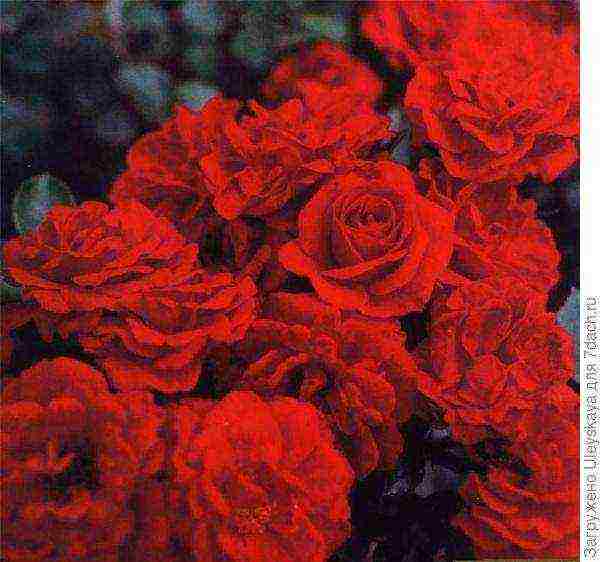
The variety was created in Germany by Kordes, whose breeders improved the flower's decorative qualities in 1978, so the variety can be sold under the name 'Zwergkonigin 78'. The bush is 50-60 cm high. The leaves are green, shiny. The flowers are large, with a diameter of 4-5 cm,
red, slightly fragrant, terry; bloom throughout the summer.
Application This miniature bright variety will not be lost anywhere: neither in flower beds, nor in containers, nor in pots.
And what miniature roses grow and bloom in your country house?
Miniature roses in landscape design (with photo)

Miniature roses in the photo
The first miniature roses appeared in China, and from there they were brought to Europe in 1810. This is a historically recorded fact, but they did not receive wide distribution in the 19th century, their triumphal procession began only in 1918, when Dr. Roulette found a miniature rose bush in Switzerland, which he later multiplied and called the “Roulette” rose. It was she who became the ancestor of almost all modern varieties of miniature roses.
Since 1823 this group has become very popular in France for decorating parterres in gardens and parks and for decorating winter gardens. Over time, interest in them waned. Around 1910, they were re-grown in large numbers in pots. About 20 species were distributed.
In Russia, these roses were grown in the collection of the Imperial Botanical Garden, which was led by the outstanding botanist E. Regel.
In 1940, Spanish and Dutch breeders began to hybridize miniature roses on a large scale. To obtain new hybrids, they used low-growing roses of other groups. Thanks to interspecific hybridization and selection, a number of varieties were obtained that retained the main characteristics of miniature roses, but received a bright and varied color, as well as an elegant flower shape.
The description of miniature roses is quite consistent with the name of the group: these little beauties are really small - their height is only 10-30 cm, but the shoots are abundantly covered with small dark green shiny leaves.
Roses can have thin, durable thorns or be smooth-bore. The flowers are small - 1-3 cm in diameter, usually double, cupped, single or collected in apical inflorescences. The flowering is abundant and long - lasts almost without stopping all summer.
Own-rooted miniature roses do not give root growth, so they are propagated by green cuttings. In the room, this is done in March-September, on the street - in May-August.
The descendants of the Roulette rose are grown today in a variety of forms: there are spray (considered classic), and trellis, and ground cover, and standard, and climbing. Therefore, their use is very diverse. Miniature roses are grown mainly as potted plants, but sometimes they can be seen on flower beds, and in flower beds, and in borders, and in garden groups, and on alpine slides.
As you can see in the photo, you can decorate walls, balconies, and decorate arches with miniature roses in landscape design:
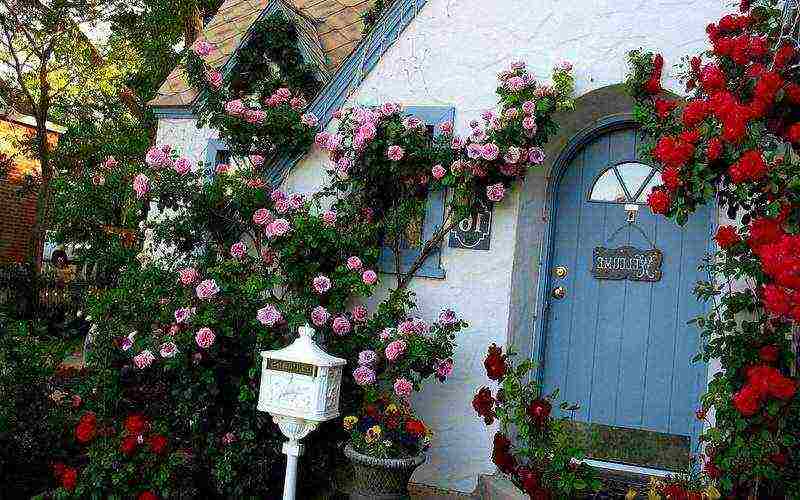
Miniature roses on the walls (photo)
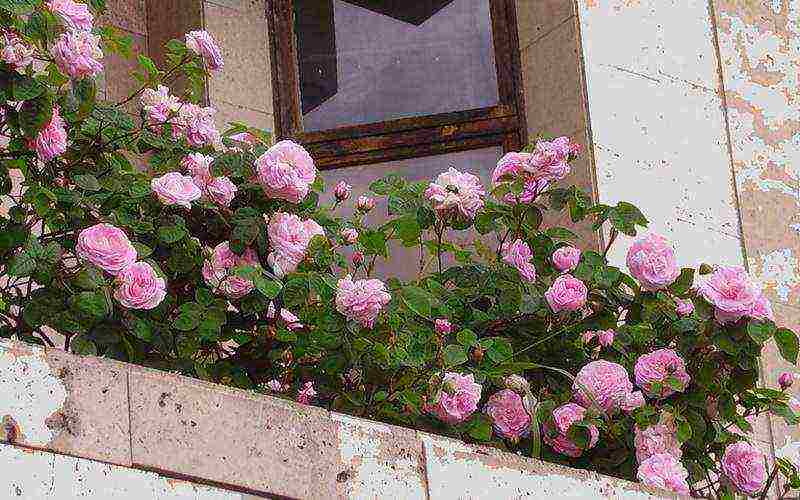
Miniature roses on the balcony (photo)
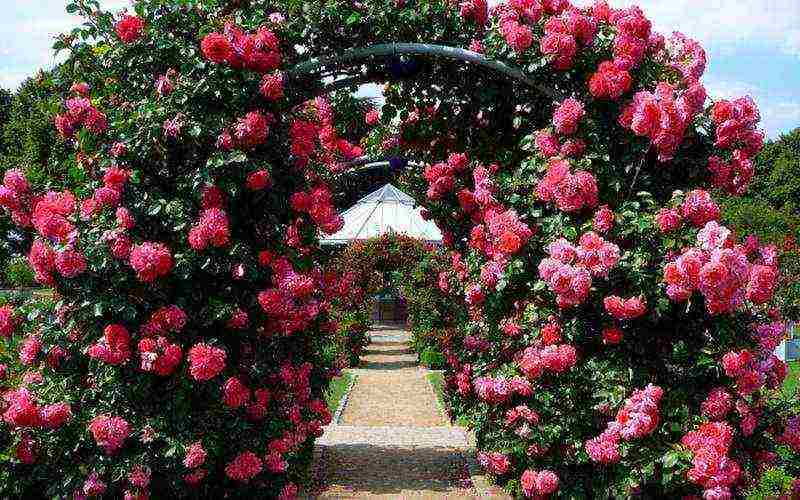
Miniature roses adorn the arches (photo)
On their own roots, the plants reach a height of 15-20 cm, the bush turns out to be compact, well leafy; grafted on rose hips - much higher (30-50 cm).
Rapidly lignified shoots grow straight, up to 80 flowers are formed on each. Leaves are compound, of 5-7 leathery shiny leaves, ovoid, finely serrated along the edge, in most varieties they are dark green, however, varieties with bronze-brown foliage or light green with dark veins are found.
Garden roses have small flowers with many petals. They do not retain their color during the entire flowering period: the bush simultaneously contains lemon-yellow, coral-pink, crimson-crimson flowers, which makes the plant exceptionally elegant.In temperate zones, the buds do not bloom for a long time, in half-release they have the form of noble large-colored roses. In hot conditions, the buds bloom on the 4-5th day and the whole bush is covered with bright beautiful flowers throughout the summer.
Cut flowers stand in water for 7-9 days without losing their decorative effect; in some varieties they have a delicate aroma.
The flowering of most varieties continues with regular watering until frost (in the southern region - 5-6 months); some weakening occurs in the hot dry months (July and August).
Look at the photo - miniature roses can decorate any garden plot:
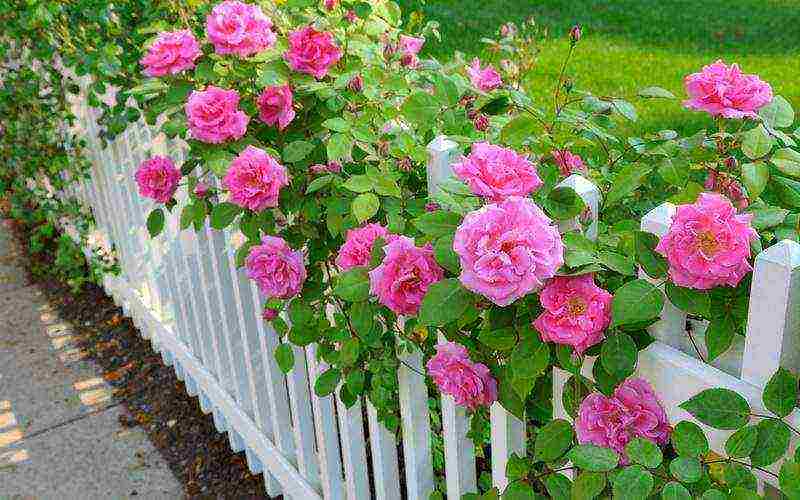
Miniature roses in the country (photo)

Miniature roses in the garden (photo)
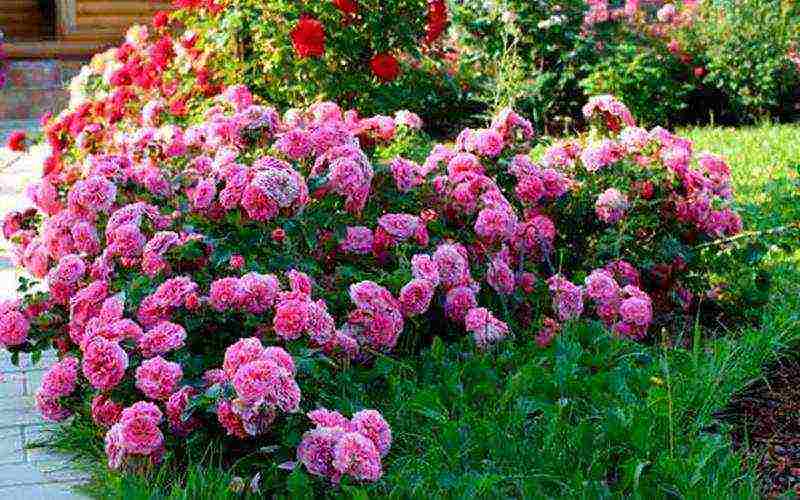
Miniature roses in the garden (photo)
They are good in groups on the lawn, in vases on the porch, along the paths, in compositions with ornamental shrubs and perennials.
Indoor varieties of miniature roses are sometimes called dwarf bush roses or patio roses, and greenhouse varieties are called pot roses. The latter usually do not exceed 25 cm in height and are grown as houseplants. Their flowers are also tiny, no more than 2-4 cm in diameter, double or semi-double, of all flowers inherent in roses.
And although miniature roses do not stretch up, they can please with rich branching. Usually these roses do not smell. Along with growing in pots, they can also be planted in small flower beds or along paths.
The indisputable advantage of growing miniature roses is the ease of their propagation by cuttings. Own-rooted roses bloom almost continuously and, without strong roots, like grafted roses, can be used as an indoor culture.
Growing miniature roses: care and pruning
Growing miniature roses is usually not difficult if you provide them with optimal conditions: a sunny place, sheltered from the northerly winds, and slightly acidic soil that retains moisture well (light loams are ideal).
Caring for miniature roses is also easy. It is necessary to regularly water the roses, loosen the soil after watering and during the growing season give four top dressing: 1st - after the bush is freed from the shelter with ammonium nitrate, 2nd - as the shoots grow with carbamide, 3rd - when buds appear with full mineral fertilizer, 4th - in August with superphosphate and potassium nitrate.
When growing miniature roses in the garden, keep in mind that, like hybrid tea, they are affected by powdery mildew, marsonina (black leaf spot), aphids and rose sawfly.
For the winter, miniature roses are covered only when the sub-zero temperature becomes stable and settles at a level not lower than -7 ° C. It is not recommended to use peat, sand and sawdust for shelter - peat acidifies the soil, sand hardens, and sawdust absorbs moisture and loses its protective properties after freezing. Dry foliage covered with agril is ideal. The bushes are spud, covered with leaves, a wire frame is installed on top, the height of which is 20-30 cm higher than the bush. Agryl is placed on the frame and all this is covered with plastic wrap on top and its ends are fixed with the help of heavy improvised materials (pipes, bricks, etc.). In this form, miniature roses winter well. In order to avoid damping in the spring in March - April during thaws, airing is carried out, opening the leeward side of the frame.
South of the Central zone of Russia, miniature roses are well preserved in winter, being covered with an earthen mound 15-20 cm high. With lower hilling in frosty winters, the shoots freeze over. In spring they grow back quickly, but bloom 5-7 days later than those that have not suffered.
Miniature roses are propagated by green and semi-lignified cuttings. Can be propagated by budding on rose hips. The difficulty lies in the fact that these roses have very thin shoots from which the eyes are taken, while the size of the eye should correspond to the thickness of the rootstock.
In these plants, the buds sit close to each other, which makes it difficult to prune miniature roses, they must be pruned to a few centimeters above the ground. 2-3 buds are left on each stem of a miniature rose. Pruning of this group of roses is carried out in the spring before the buds swell.
Miniature roses, unlike large-flowered ones, need more careful care. To preserve their decorative effect, it is necessary to regularly remove wilted flowers.
You can decorate balconies, loggias, terraces, small flower beds with these roses, but you should know that the scent is a rare phenomenon for these plants. And further. If the balcony is flooded with bright sun all day, the roses will feel bad on it. Constant exposure to the sun is categorically contraindicated for miniature roses - in this case, their flowers bloom one after another so quickly that it is impossible to remove faded ones in time. From this, flowering gradually becomes less and less abundant, and soon the bushes lose their decorative effect.
Next, you can familiarize yourself with the photo and description of miniature roses, the most popular among flower growers.
The best varieties of miniature roses: photo and description
Currently, the following are considered the best varieties of miniature roses.
Orange Jewel - Salmon-orange flowers, large, densely double, noble shape, do not fade for a long time. The bush is strong, compact, grows easily. The height of this variety of miniature roses is 30 cm.
"Amulet" - flowers of rich pink-red color, large, densely double. The foliage is green. The bush is dense, fast growing, healthy. This variety is renowned for its charming flowers and abundant and long-lasting flowering. Height - 50 cm.
Little Baccarat - low (up to 25 cm) bush, spreading. Leaves are shiny with a bronze tint. The flowers are semi-double, red-crimson with a white center. They have a pleasant scent.
"Baby Baccarat" - are distinguished by the ideal shape of the flower, velvety red, almost black in color.
"Garnet" - densely leafy bush, strong, shiny, dark leaf, abundant flowering. The flowers are large (up to 5 cm in diameter), perfectly shaped, crimson-red.
Common varieties "Baby Carnival" with pink-red flowers,
Pixie, White Jam — with whites,
"Eleanor" - with coral pink.
This selection contains photos of the best varieties of miniature roses:
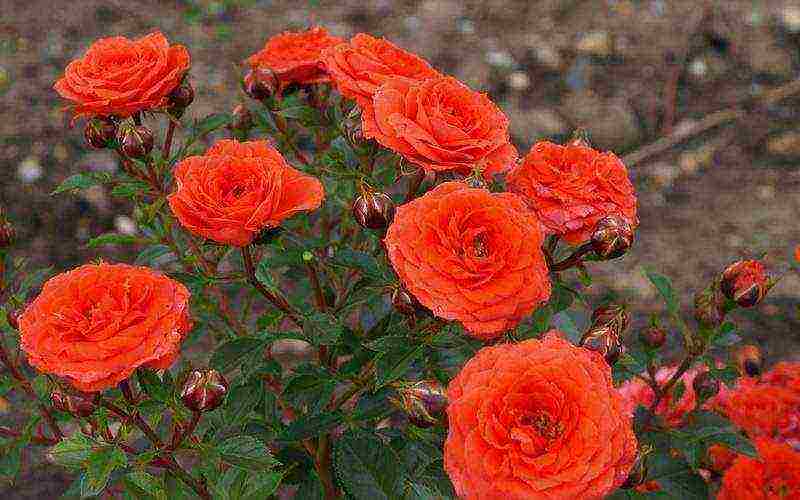
"Orange Jewel" in the photo
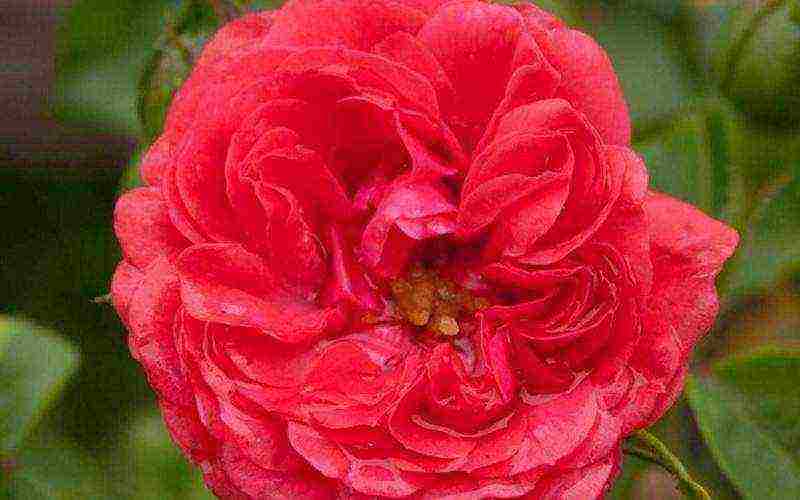
"Little Baccarat" in the photo
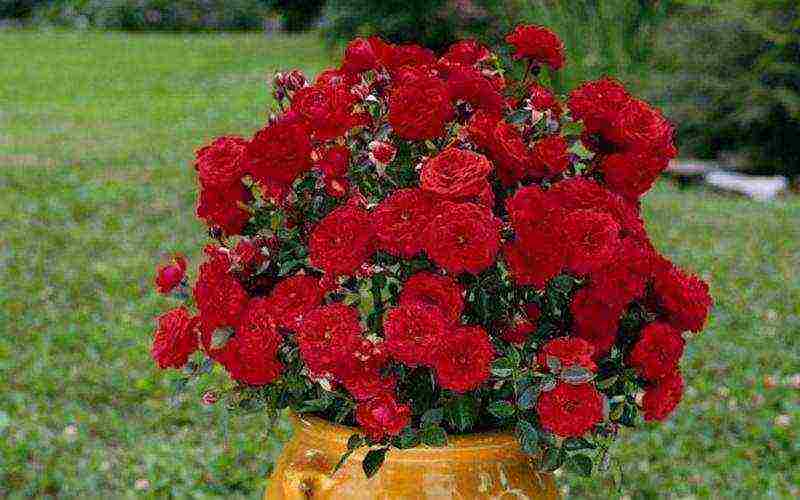
"Baby Baccarat" in the photo
Rate the article:
(0 votes, average: 0 out of 5)
Summer residents and gardeners love to decorate their backyards with flowers. In many courtyards, you can see large flower beds and flower beds. Some people even create indescribable beauty from flowers, forming flower beds of continuous flowering. One of the main beauties is the rose. She is rightfully considered the queen of the flower world. It is she who, to a greater extent, is given special preference by both amateur gardeners and professionals. Therefore, many people want to choose the best varieties of roses. How to make the right choice and what should be considered?
The main criterion for the abundant flowering of the bush is the environment and soil characteristics. As many gardeners note, no matter which variety of roses is chosen, you can create a fertile soil for it yourself and concentrate the beds anywhere you want. Thus, the problem with the difference between the flowers you like and the soil conditions unsuitable for them is solved.
Roses with so-called complex colors are very demanding to the composition of the soil. The petals of such flowers have a combination of several shades. They can be very different and combine smooth or sharp transitions. Modern breeders have learned to breed amazing species of this plant, which have not only complex coloring, but also an incredible shape. On unsuitable soil, such plants acquire a depressed state, an unsightly shape and a dull color. Their life cycle is significantly shortened.
Very often people choose David Austin roses. The varieties of these flowers are intended mainly for cultivation in partial shade and in loamy soils. Such conditions are typical for many other species. If we consider in general the soil conditions and the location of the flower bed, then these flowers love light breathing earth. It is categorically impossible to plant seedlings in clay, sandy and sandy loam soil, since it poorly permeates moisture and, practically, does not allow air exchange between the root system and the soil. Experts recommend, in this case, to carry out a double digging with the addition of chernozem, peat, sod land and well-rotted manure. In this case, the proportions should be kept approximately equal.
The best place to plant roses is on the southeast side of your patio, garden or backyard. The place should not be dark, shaded by buildings, trees or ornamental shrubs.
As for the climate, then the resistance of a particular plant species to changeable weather conditions, to cold weather, heat and lack of air humidity should be taken into account. Are absolutely contraindicated for the colors of the place of north-western orientation at the summer cottage. Plants are very sensitive to drafts and cold winds, so roses will not grow well in such areas.
Classification of varieties of roses. What types are there and how to distinguish between them?
The opinions of many experts and florists boil down to the fact that before you start growing these beautiful flowers, you need to find out as much information as possible about them in order to avoid mistakes. After all, in the end, every grower, regardless of qualifications, wants to get high-quality, fragrant and beautiful roses. Species and varieties are divided into several categories. In each of them, there are the best options that have proven themselves on the positive side in all respects.
The most beautiful and common types of roses are:
- Floribunda.
- Hybrid tea.
- Grandiflora.
- Groundcover.
- Climbing.
- Shrubs.
- Selected by David Austin.
When choosing a variety, you must take into account your preferences and tastes, then your favorite flowers will appear on your personal plot.
Floribunda roses. Varieties, photos, description
The history of these flowers began in 1924, when the Danish originator by the name of Poulsen first bred the original flowers of this type, which were called hybrid-polyanthus. At first, they belonged to the general category of tea roses, and were bred into a separate group in 1976. Some experts note that floribunda roses are intermediate varieties between the two types (hybrid tea and climbing). A distinctive feature of these colors is the diversity in everything. This is especially true for the combination of shades and tones. As a rule, they are rich, colorful, juicy.
General characteristics. The height of the bushes varies from 40 cm to 1.5 m, about 35 inflorescences can be collected on one stem. The flowers themselves have from 8 to 24 petals, the edges of which are distinguished by medium doubleness. In shape, some varieties resemble a narrow or wide glass, while others can bloom with flat or cupped buds.
The description of floribunda rose varieties also shows that their individual specimens can have golden clear shades, which are distinguished by a glossy surface and rigid petals. Such plants have an average height (about 1 meter). They are also characterized by larger flowers, which are collected in small inflorescences.
It should be noted that floribunda is a continuous flowering rose. They are also resistant to frost, fungal and viral diseases. This is an excellent solution for decorating your summer cottage or home yard.
The best floribunda roses, varieties with photos:
- Golden Vedding (Golden Wedding) German selection.
- Samba. Germany, selection W. Kordes.
- La-Paloma (La Paloma). Germany, breeding Tantau
- Lion-Rose. Germany, selection Kordes.
- Leonardo da Vinci. France, breeding Meilland.
- Tchaikovcki. France, breeding Meilland.
- Gebruder Grimm. Germany, selection Kordes.
- Pomponella.Germany, selection Kordes.
- Jubile du Prince de Monaco. France, breeding Meilland.
- Koncerto (Concerto). France, breeding Meilland.
- Purpl Tiger (Purple Tiger). France, breeding Meilland.
Hybrid tea roses: varieties, photos, description
This group has a very interesting history. Back in 1867, the Frenchman J.-B. André Guillot was engaged in the cultivation of flowers that were unique at that time. For years he experimented with La France, crossing remontant and tea roses. As a result, he created a beautiful plant that had many differences and its own unique zest. Then André Guillot positioned his brainchild as a variety of bourbon roses.
In the description of varieties of hybrid tea roses, their main feature is listed - the continuity of flowering. Also characteristic of these flowers are easily-cranked or straight stems, which have increased strength. They create erect, slightly spreading shoots. The varieties of hybrid tea roses were classified into a separate group in 1997.
The bushes are characterized by low shoots. Their length is a little less than a meter, they have large racemes with 4-7 leaves. Most often, flowers are collected in small inflorescences of 4-6 pcs. Shades are very different (in some varieties, several colors can be combined). There are new varieties of hybrid tea roses that have complex large double flowers.
Almost all varieties of hybrid tea roses have a beautiful appearance and are perfect for decorating not only a summer cottage, but also premises. The average period of initial, active flowering lasts about a month. Then comes the time to move to the next stage - the emergence of new flowers (15 days for early varieties and 30 days for later). Then they bloom continuously until the first frost.
The best varieties of hybrid tea roses:
Medium-sized varieties:
Red-pink varieties:
Rose varieties of the Grandiflora group
A relatively new type of flowers, developed for decorating gardens. They look like a low-growing tree, about 1.5-2 m high. This group of flowers was obtained by crossing floribunda and hybrid tea varieties. Grandiflora embodies the best qualities of these varieties. They have a very attractive appearance and a wonderful aroma. Notable properties are resistance to disease and frost.
The best varieties of Grandiflora roses:
Ground cover roses: varieties, photos, description
The name of this group contains the main answer to the question about the main characteristics of the plant. Groundcover - low-growing roses that are able to cover a vast area of the flower bed with long shoots with many flowers blooming on them. The length of the shoot can at times reach up to 4 meters. Thus, nature creates a natural, beautiful carpet.
There are also ground cover roses, varieties of which, in addition to creeping on the ground, shoot drooping shoots. This type of growth provides an indescribable beauty to the bushes. Some species bloom once a year (they are rarely used by summer residents). It is the continuously flowering varieties of ground cover roses that are very popular.
Roses also have ground cover varieties (see photo), which are characterized by a variety of shades (light pink or pale crimson, red and dark red, light red or pure white). The buds have a variety of sizes.
Another feature of these flowers is frost resistance. Many varieties do not shed their foliage until spring. They are good for decorating columns or walls in the yard. Despite this, the base of the plants should be covered for the winter.
Ground cover roses, winter-hardy varieties (photo):
Roses shrabs: varieties, photos
Speaking about this group of flowers, one can note their main feature - a magnificent aroma, neat, upright bushes, abundant and continuous flowering. Flowers can be of various shapes (there are small ones, and there are large ones, the diameter of which reaches 12 cm). Petals are double, semi-double or simple.The leaves do not have a glazed surface; they can be dark green with a burgundy tint.
It should be noted that shrub roses were introduced into a separate group in 1954. It was then that many very beautiful species of this plant appeared.
Due to its structure and powerful root system, the formation of a bush is very easy, the main thing is to cut it on time. For example, flower growers very often form a ball, cone or strict square. This is not difficult to do. Some summer residents use this plant to form a decorative hedge to highlight one or another area of the personal plot.
Roses are grown shrabs (see varieties with photos) summer residents, both in separate flower beds, and in combination with other types of flowers. They are often used in the planning of gardens or parks, which is why shraba roses are called landscape or park roses.
There are three groups of scrub (park) roses:
- Curly - the length of the shoots is from 5 to 16 m.
- Climbing - the length of the shoots is up to 6 m.
- Semi-plaited - the length of the zero shoot reaches a little more than 3 m.
Erect bushes can reach heights of up to one and a half meters. Among the advantageous properties is frost resistance (especially Canadian park roses, the varieties of which can withstand a temperature drop of up to 350 C of frost). They bloom all summer until late autumn continuously, delighting the eye with their indescribable beauty and aroma.
The best varieties of scrub roses:
Roses bred by David Austin
The origin of this group of flowers is very interesting. An English breeder named David Austin began breeding completely new types of roses. He experimented for a long time, crossing classic floribunda and tea hybrid with varieties of long-forgotten old French and Damascus roses, which had already lost their popularity and demand among gardeners and summer residents.
As a result of his hard work, flowers of a completely new format were obtained, which began to be called Austin roses. The varieties he bred have very attractive shapes, with intricate petals and the structure of the bud itself. They are also characterized by new aromas. Many experts compare the smells of these flowers with the aromas of expensive, natural and real teas.
The best varieties of Austin roses are very beautiful and are often grown for the trade. Despite the variety of forms of shoots, bushes and the abundance of flowering, the presentation of all varieties of rose leaves is not lost.
The work done by the English breeder has a great price. For example, breeding a single resistant variety requires 4 to 8 years of diligent attention and careful approach. Austin devoted his whole life to this business, which is more than 60 years. From a very young age, he started a business that brought him the most pleasure. The nursery he created, which is located in Shropshire, is still engaged in breeding new types of Austin roses. The catalog of varieties with photos is constantly updated with new types of these flowers, which have incredible beauty and advantageous properties.
It should be noted that the climatic location of Shropshire (western part of England) contributes to the endowment of Austin flowers with unique properties - resistance to severe weather conditions and diseases.
Austin roses, photo varieties:
Climbing roses: continuously flowering varieties
According to the description and characteristics, the budding and flowering phases of these beautiful plants are very extended. Shoot formation occurs constantly. This property contributes to the continuity of flowering. This period can last up to six months without interruption. Paying attention to this feature, many designers and flower growers use them to decorate complex and simple building elements of their homes and courtyards. The best, in this regard, are Climings or Banks.
Also, varieties of climbing roses that grow all summer can be divided into three groups according to the nature of their growth:
- Curly. The length of the shoots is up to 15 m.
- Climbing. Shoot length up to 5 m.
- Semi-plaited. The length of the branches does not exceed 3 m.
This classification is not accidental.The fact is that claimings bloom on young shoots, and ramblers use branches from past years. The approach to plant breeding and the formation of a beautiful, climbing bush depends on this nuance.
The most beautiful varieties of climbing roses:
This article provides a description and photo of the most popular, beautiful, fragrant and original varieties of roses. Therefore, flower growers and summer residents have a good opportunity to purchase those flowers that best suit his tastes and requirements.
Roses have long been considered one of the most important decorations in any garden. Besides, what kind of girl can refuse a bouquet of these fragrant flowers. A gardener who wants to plant this wonderful plant for the first time has a huge selection of different varieties and subspecies. Which one to give preference? Below will be presented the most popular and new roses among several categories.
The best types of climbing roses, names and descriptions
Plants are distinguished by the presence of long and flexible shoots, the length of which can reach 5 meters. These roses can be used to create spectacular arches, walls or flower cascades.... This is because they do well on various horizontal or vertical supports.
Usually, the flowers of climbing roses are small, and almost the entire shrub is strewn with them. The start time and the duration of flowering directly depends on the selected variety.
Pomponella (Pomponella)
Rose Pomponella
The shrub is small in size, its shoots grow to a length of 1.5 meters. The flowers are very unusual in shape, closed and rounded, like a pompom. The color of such buds is bright pink, and many gardeners also note the presence of a bright aroma... The variety gained its popularity not only due to its appearance, but also due to its unpretentiousness and immunity to many diseases.
Flamingant (Flammentanz)
Rose Flammentanz
A distinctive feature is resistance to diseases and the ability to withstand frosts down to -30 degrees. The shrub grows up to 3 meters long and 2 meters wide... The buds are colored bright red, have a terry texture, large size and pleasant aroma.
New Down (New Dawn)
Rose New Dawn
It is the most resilient and popular climbing rose variety. The shrub is very powerful and vigorous, capable of withstanding any, even the most unfavorable weather conditions... Terry pale pink flowers adorn the plant from late spring to early autumn, moreover, they are not afraid of gusty winds and heavy rains.
Golden Gate (Golden Gate)
Rose Golden Gate
It was bred in 2006 and is already highly popular among flower growers. The shrub grows up to 3.5 meters in height, is characterized by a large number of shoots... The buds are bright yellow, fairly large in size, the texture of the petals is terry. This variety is not whimsical to growing conditions and care, it is immune to many diseases.
Iceberg (Iceberg)
Rose Iceberg
An ancient variety that continues to be in demand today. The shrub is small, only 1.5 meters in height, completely covered with snow-white flowers... The buds are medium in size, classic in shape, distinguished by the presence of a delicate aroma. In addition to its bright appearance, such a flower takes root well in almost any climate.
Varieties of hybrid tea roses
The most popular group of shrubs, represents roses with compact tall shoots, on the tops of which large buds of various colors are formed.
Gloria Day (Gloria Dei)
Rose Gloria Dei (Gloria Dei)
Although it requires sufficient attention to itself, in the form of additional shelter for the winter and protection from diseases, it is one of the most beautiful and popular types of hybrid tea roses. The shoots are powerful and straight, grow up to 120 centimeters in height, the flower is very large (diameter 16-18 centimeters) and beautiful... The color of the bud is pale yellow, along the edges you can see a pink border. The structure of the flower is terry, and the shape is cup-shaped;
Superstar (Super Star)
Rose Super Star
Very persistent and beautiful, on one shoot, up to 110 centimeters long, one or more bright coral buds are formed, a terry structure and a glass-like shape. The flowering period lasts from the beginning of summer to the onset of the first frost. Another advantage will be long-term preservation in the bouquet;
Landora (Landora)
Rose Landora
Resistant to cold weather and some diseases, the shrub grows up to 120 centimeters in height. Deep yellow buds with slightly elongated petals look good as a decor for any summer cottage;
Paradise (Paradise)
Rose Paradise (Paradise)
It is popular for its unusual color of the flower, which changes as it unfolds. Initially, the bud is painted in a light lavender color, then the petals become bright pink, crimson and seem to frame the lighter center. These roses are often used for cutting;
Blue moon (Blue Moon)
Rose Blue Moon
Such flowers have an unusual, lilac color of the petals and are popularly called "blue". The shrub is low, only 90 centimeters, the foliage is frequent, glossy dark green... Lilac buds consist of 35 terry petals. It also has an exquisite aroma and is not afraid of cold weather. The disadvantage is the high risk of powdery mildew infection.
Roses with the largest flowers
This type includes varieties the bud diameter of which exceeds 12 cm, the brightest varieties are:
Polka (Polka)
Rose Polka
The shrub of such a rose reaches 3 meters in height, the foliage is abundant and glossy. The flowers are very bright and beautiful, in the middle they are painted in peach color, and at the edges in soft cream. The diameter of the bud is 14-16 centimeters, the edges of the petals are wavy... Flowering continues throughout the season.
Paul Nero (Paul Neyron)
Rose Paul Neyron
The thornless shrub reaches a height of 100-150 centimeters, the foliage is very large and shiny. The flowers reach 18 centimeters in diameter and are considered the largest, they are very similar to peonies in their spherical shape and wavy edges of the petals... The color of such roses is deep pink, the structure is terry. The main disadvantage is poor frost resistance and susceptibility to certain diseases. Under favorable conditions, it can bloom every 1.5 months;
Ravel (Ravel)
Rose Ravel
A hybrid tea variety of a rose, it is a medium-sized shrub with a large number of shoots and dense, closely green foliage. Usually, only 1 bud is formed on one shoot, it is extremely rare that there can be 2 or 3 of them... Flowering occurs with pale pink, double goblet-shaped buds. On average, the diameter of a rose is 12 centimeters. The variety is resistant to cold weather and most diseases;
Dam de ker (Dame de Coeur)
Rose Dame de Coeur
The shrub is small and neat, it grows no more than 1 meter in height, the leaves are numerous, dark green in color. It blooms in waves and the rose can bloom several times between mid-June and late September.... The buds are cupped, dense, with double, deep red petals that do not fade in the sun. The diameter of the bud is 12 centimeters. The variety is not afraid of frost and most fungal diseases.
The most beautiful varieties of miniature and dwarf roses
Dwarf roses include varieties whose shrub height does not exceed 35 centimeters.... They look good in a variety of compositions and are often grown as a kind of living border.
Hummingbird (Colibri)
Rose Hummingbird (Colibri)
There are two roses called Colibri with golden yellow flowers. The first appeared in 1958, and in 1978 its improved version was introduced. A very bright variety resistant to diseases and unpretentious in cultivation. The shrub grows no higher than 25 centimeters, the buds are collected in inflorescences of 3-5 pieces and delight with their beauty right up to the fall.The flowers of the Hummingbird are small, double, bright, yellow-orange.
Meidi (Maidy)
Rose Maidy
Rosettes of bright red color with a silvery bloom on the back. The shrub, in turn, grows to a length of 35 centimeters and has good resistance to disease and frost... The buds bloom profusely throughout the summer.
Rosemary (Rosmarin)
Rose Rosemary (Rosmarin)
A small shrub with dense, dark green foliage is not afraid of frost and many diseases. Sami buds of soft pink colorslightly silvered.
Amulet
Rose Amulet (Amulett)
The height of the shrub is on average 50 centimeters, the foliage is very dense, rich green, and has a high growth rate. The flowers are large, densely double, have a bright pink color... The variety is famous for its long flowering and a large number of buds formed, moreover, a small bush is not afraid of the appearance of many diseases.
Baby Bakara (Baby Baccarà)
Rose Baby Baccarà
A very unusual variety of red shades, the flowering of which occurs in buds of the classic form of burgundy, saturated color. The shrub is low, only 25 centimeters, the crown is spreading, the leaves are shiny, with a bronze tint.
Long-stemmed yellow, orange and red rose varieties
Long-stemmed roses are usually grown for later cutting.because they look majestic and extraordinarily beautiful.
Cardinal 85 (Kardinal)
Rose Cardinal 85 (Kardinal)
The stem of a rose of this variety can reach a height of 125 centimeters, the buds are bright red, but after 2 weeks they become bright crimson. A feature of the variety will be the curl of the upper layer of the petals. and a beautiful goblet shape.
Aalsmeer Gold (Aalsmeer Gold)
Rose Aalsmeer Gold
Classic rose of bright yellow color, the stem grows up to 1 meter in length... The shrub is covered with dark foliage, the thorns are practically absent.
Queen Elizabeth Elizabeth)
Rose Queen Elizabeth (Queen Elizabeth)
The stems, which form pink inflorescences, can be up to 1.5 meters in length. Velvet buds, terry, consist of 30-35 leaves, bloom with a very delicate, pink shade... Also, these flowers have a wonderful scent. This variety blooms from late June to November. With proper care, the variety tolerates winters in central Russia well, and is resistant to a large list of diseases.
Forever Young (Forever Young)
Rose Forever Young
The stem height of this variety reaches 1 meter. A medium-sized shrub, practically without thorns. Terry buds, velvety, on average, their diameter is 10 centimeters... The petals have a very intense red color and are popular with many gardeners. The variety is resistant to many diseases, not afraid of frost. Also, such a rose in the cut retains its freshness for a long time.
All roses are the queen of any garden, regardless of the color of the bud, leaves and size of the shrub. This fragrant flower fits perfectly into absolutely any ideas and compositions.
